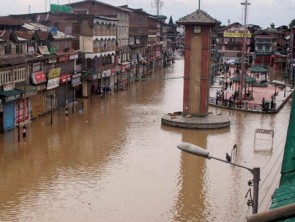Among the government agencies at present only the Central Water Commission (CWC) has a Flood Forecasting cell which provides flood forecasts in different parts of the country based on in situ measurements of flow and water level characteristics at different sites combined with weather forecast inputs from the IMD.

The forecasts that the CWC gives are basically projections about the likely water level in the rivers 12, 14, 16 and 18 hrs in advance. The CWC warns the concerned state authorities when the water level at the forecast site is above the ‘Warning level’, which is generally 1 m below the ‘Danger level’.
This downstream level forecast is based on actual observed water level data up stream, which is measured on an hourly basis during the monsoon period. Whenever there is significant rainfall activity in the upper reaches, the up-stream level data is combined with rain gauge data if there are rain gauges at those locations. Rainfall in the upper reaches eventually discharge into the riverine system causing the river levels to increase.
Rainfall forecast data from the India Meteorological Department (IMD) also provide added inputs to the CWC’s flood level forecasting system.
But, as Vishnu Deo Roy, Director, Flood Forecasting unit, the CWC, points out, there is always some uncertainty in these rainfall forecasts. These level forecasts are made using statistical models that use 10 years of past river data. The CWC operates a network of 878 hydrological sites, data from which are used for level forecasts at 147 sites.
Water being a state subject, the CWC takes up the issue of locating such sites only after receiving requests from the respective States. Considerations such as the availability of hydrological/meteorological observation sites upstream of the forecast station, the average time taken by flood wave to travel from the observation site to the forecast site, and the past history of flood problem in the area are also taken into account in locating the sites.

Selection of the sites is followed by finalizing certain parameters, such as the Danger Level, in consultation with State-level bodies involved in flood management.
“The forecasts issued by the CWC generally cater to the flood of general nature having sufficient warning time available,” Deo Roy had written in response to an article by Himanshu Thakkar of the South Asia Network on Dams, Rivers and People that had highlighted the apparent failure of the CWC in forecasting Uttarakhand floods. “The hilly regions experience flash floods on many occasions, which is very difficult to predict due to the fact that flood wave in these rivers travels at a very high speed due to steep slopes.
The lead time in such a case is very less as compared to that required in a general flood forecast system,” he wrote.
In the context of the present floods in J&K, and Assam and Meghalaya, it is pertinent to note that, notwithstanding the flood proneness of J&K, in particular the Jhelum valley where Srinagar city is situated, the CWC has not set up a single forecasting site in J&K.
“The State Government has not complied with the required protocols,” Deo Roy said.
When asked to elaborate, he merely said “It is a complex issue but includes finalization of parameters such as warning time and danger level”. While Assam has several flood forecasting sites, Meghalaya has none.

The issue, which involves Centre-State engagement, is indeed complex. According to a former senior official of the CWC, who was more forthcoming in this regard but did not wish to be quoted, a state has not only to first request the CWC for a hydrological site or a forecasting site to be established but also should offer to provide the necessary support for its operation which is then formalized into an agreement.
“But states,” he added, “generally do not realize the importance and the necessity for such things. They particularly do not care if the places where data is to be collected are in protected or politically sensitive areas. As regards J&K there has also not been any serious attempt on the part of the Centre to find a solution to the issue.”
The infrastructure for such a site, according to him, basically involves a junior member of the CWC engineering staff, one or two khalasis (labour engaged in water works), water level and velocity measuring instruments and a boat to make measurements in the river water.
Without naming the state he referred to a case in the past in a border state where a political party not in power demanded huge amounts of money to let such a site to be established and function. This state, he added, still does not have a flood level forecasting site. In another case when khalasis of a state went on a strike during the monsoon season, the operation came to a standstill.
He also pointed to cases of theft and pilferage of equipment, in particular boats, in the poorer states. When there is unrest or something the state often does not offer any protection so that the person manning the site can stay put.
“For states like J&K we should think in terms of external alternatives, say the army or paramilitary personnel, to maintain and operate such sites. They have the wherewithal to manage such things especially when many other operations are under their control,” he suggested. But now, having been jolted out of its slumber, it appears that the ministry of water resources is now getting its act together to set up forecasting sites in J&K.
Hopefully they will do so in the other vulnerable states that do not have any forecasting sites as well.
………………………………………
* R. Ramachandran is a veteran Indian science journalist and currently a consultant with Frontline. A PhD in Physics, he worked as the science editor for the Economic Times and Business India and associate editor of Frontline.


Comments are closed.